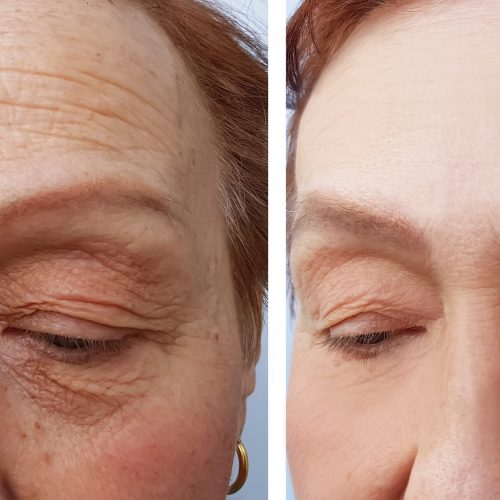This guide uses information from the American Society of Plastic Surgeons, Cleveland Clinic, and other medical research (see below) to explain how Dysport compares to Botox for cosmetic procedures.
The bottom line: Both products have the same active ingredients and are considered safe and effective treatments. But there are a few important differences—most notably how quickly they work and how much the treatment “spreads” that are worth considering.
Read on to learn more about how quickly Dysport shows up in your face compared to Botox injections, which one may appear more natural than the other, how the costs differ, and which option is the best way to reduce wrinkles for you and your skin/situation.
Biggest Difference in Dysport vs. Botox: How Fast It Shows Up
Dysport and Botox are both brand names of drugs that contain the active ingredient botulinum toxin type A. They both essentially freeze nerve signals to the facial muscles, which can eradicate or reduce the appearance of wrinkles. But Dysport has smaller proteins attached to the toxin molecules compared to Botox. And that means that Dysport can spread out more quickly and further than Botox.
In practical terms, that means Dysport shows up faster than Botox. Most sources we reviewed said it took 2-3 days for patients to see the effects of Dysport injections, while Botox takes about a week. So if you are getting injections before a big event in a few days, Dysport may be a better option for you.
Dysport vs. Botox: More Natural, Less Needles?
Dysport spreading faster also means that some providers view Dysport as more natural looking, because it spreads out more and doesn’t freeze the muscles and restrict facial expressions as much. This point wasn’t unanimous among providers, so it’s worth discussing the key differences with your provider.
And because Dysport treatments spread faster than Botox, it can require fewer needle sticks in the injection site. That also means it is better suited for treating larger areas, like forehead lines, instead of small, targeted areas, like crow’s feet.
What Dysport Is Approved for Vs. Botox
Dysport was approved for cosmetic treatments by the FDA in 2009 to treat glabellar lines, the vertical wrinkles that can show up between the eyebrows, especially when someone frowns or scrunches their face. (These are also known as “elevens” because they can look like the number 11.)
In contrast, Botox was approved by the FDA in 2002. Over the years, it has been approved for use on glabellar lines, the forehead, and the “canthal lines,” also known as crow’s feet, or the wrinkles that show up on the outside of the eyelid.
That being said, providers can choose to use FDA-approved products “off label” on areas beyond those with FDA approval. So, some providers may choose to use Dysport to treat crow’s feet, for example, or other smaller areas of the face.
Costs of Dysport vs. Botox
Dysport may appear a lot cheaper than Botox at first glance, but they end up costing about the same per treatment. That’s because Dysport has a lower concentration of active ingredients in each vial compared to a unit of Botox, so you need more units of Dysport to complete a treatment. According to the American Society of Plastic Surgeons, the average cost for any botulinum injection (including Botox, Dysport, Xeomin, and Jeuveau) is $466. Of course, averages can vary a lot depending on where you live and how large of an area you are trying to treat.
It can also depend on what your provider prefers to use. If they recommend Dysport to most of their clients, for example, they may get a deal from the manufacturer for purchasing in bulk. Again, its best to ask your provider about this.
Dysport vs. Botox: Which Lasts Longer?
We found the most DISAGREEMENT over which treatment lasts longer. The majority of sources said Dysport and Botox generally last the same length of time, around 4-6 months. Some sources said Dysport lasted longer, some said Botox treatments lasted longer. Some providers said it largely depends on the individual patient (for example, if you have thicker than average skin) and/or the treatment area (are you treating a broad portion of the face or smaller area?).
Botox’s manufacturer says it is effective for glabellar lines for 3-4 months. Dysport’s manufacturer says it lasts for up to 4 months.
Dysport vs. Botox vs. Fillers?
Both Dysport and Botox reduce the appearance of wrinkles by relaxing or freezing muscle contractions. In contrast, cosmetic use dermal fillers add volume to the face, typically with hyaluronic acid (although there are other injectable treatments). Most people are familiar with fillers for the lips, but in some parts of the face, treating the appearance of fine lines and wrinkles might be best done with fillers. For example, fillers may be the best option to address a baggy under-eye area, or very deep laugh lines that form on the sides of the mouth.
Sources
What’s behind the cost of Botox and injectable fillers? | ASPS (plasticsurgery.org)
Wrexham-Leaflet-Dysport_300U500U-USA-6-1.indd (galderma.com)
BOTOX Cosmetic-USPI-Clean-10Jul2020-v2.0USPI3919-v5.0MG1145 (rxabbvie.com)
Dysport vs. Botox: What’s Better for Wrinkles? – Cleveland Clinic
Botox vs Dysport: what’s the difference -Eternal Dermatology Columbia MD
Dysport vs. Botox: What the difference is and more (medicalnewstoday.com)
What’s the Difference Between Botox® and Dysport®? : Selah MediSpa: MedSpa



